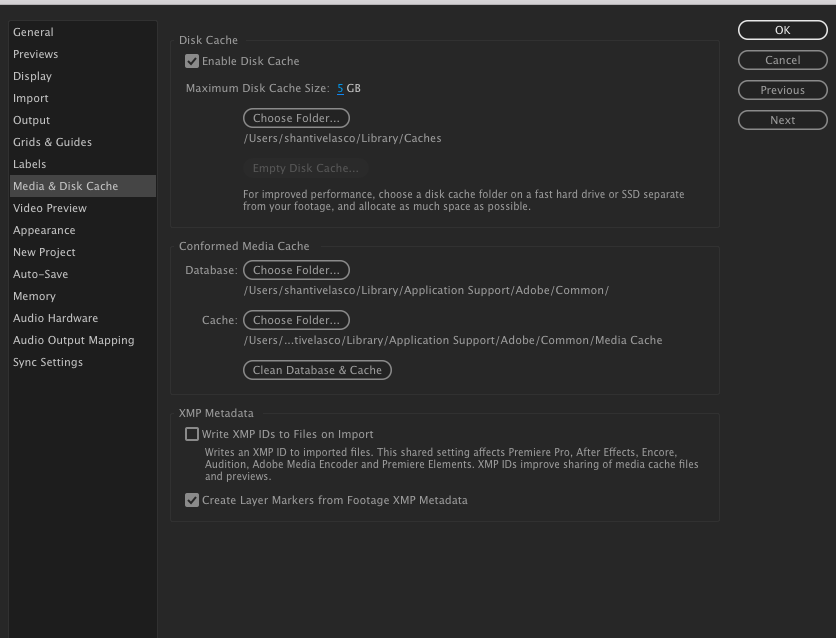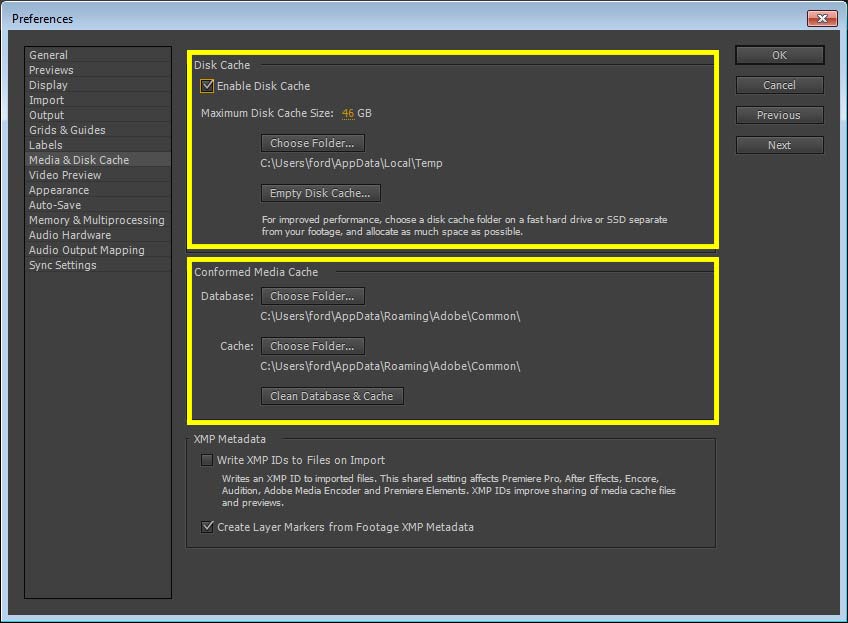Clear Cache After Effects
In After Effects you can find the tool under the Windows tab Wiggler. Here is how the wiggler tool works. Create a text or a shape layer; Create your first keyframe and your last keyframe; Select Position; Go to the Wiggler Windows and click Apply; Once you click Apply, the Wiggler tool will create multiple keyframes to make the wiggle animation. How to Clear After Effects Disk Cache. In the pop-up window, press the “Empty Disk Cache” button in the “Disk Cache” section. Click “OK” button in the appeared window. Click on the “OK” button inside the Preference Window. The After Effects disk cache is now cleared. No related posts. After Effects will cache RAM Preview frames within its RAM Cache in the same way that it caches data to the disk. This again is all a way for After Effects to increase its productivity for the user by not having to re-render a comp every single time you hit the spacebar.
The following sections describe the Preferences dialog box and the various tasks that can be performed using this menu.
To open the Preferences dialog box, go to:
- Edit > Preferences > [category name] (Windows)
- After Effects > Preferences > [category name] (Mac OS)
Use the following keyboard shortcuts to open the Preferences > General menu:
- Ctrl+Alt+; (semicolon) (Windows)
- Command+Option+; (semicolon) (Mac OS)
To restore the default preference settings, press and hold the following keys while the application is starting.

- Ctrl+Alt+Shift (Windows)
- Command+Option+Shift (Mac OS)
How To Clear Cache After Effects
To restore default keyboard shortcuts, Alt-click (Windows) or Option-click (Mac OS) the OK button.
Empty Disk Cache After Effects Cc
To reset background preferences, follow these steps:
MacOS
- Go to your desktop and click GO on the menu bar.
- Select Go to Folder from the drop-down and type the following path: /library/application support/adobe/.
- Open Documents folder and select the folder named Adobe.
- Rename the After Effects folder as ’OldAfterEffects’.
Windows
- Access the path C:Users”username” AppDataRoamingAdobe. OR
- In the Run command (Win key+R) dialog, type %appdata%
- Open the folder named Adobe.
- In the folder, select the After Effects folder and rename it as ’OldAfterEffects’. OR
- Access the path C:Users”username”DocumentsAdobe and rename the After Effects folder as ’OldAfterEffects’.
Preferences, including keyboard shortcuts and workspaces, are stored as files in the following locations:
- (Windows) Users[user_name]AppDataRoamingAdobeAfter Effects[version]
- (Mac OS) /Users/[user_name]/Library/Preferences/Adobe/After Effects/[version]
To reveal the preferences in After Effects, go to:
- Edit > Preferences > General and click Reveal Preferences in Explorer button (Windows)
- After Effects > Preferences > General and click Reveal Preferences in Finder button (Mac OS)
It is recommended that you do not modify the files in this directory manually; use the Preferences dialog box to modify the preferences. For information on modifying keyboard shortcuts, see Modify keyboard shortcuts. For information on managing workspaces, see Workspaces and Panels.
Note:
The Library folder in Mac OS X is hidden. See the following article to learn how to access hidden user files on Mac OS:
The following list briefly describes the different options listed under the Edit > Preferences menu, especially those options that are not self-explanatory.
Path Point and Handle Size: Specifies size of Bezier direction handles and vertices for masks and shapes, direction handles for motion paths, and other similar controls.
Show Tool Tips: After Effects user interface tips
Create Layers At Composition Start Time: Layers overview
Switches Affect Nested Comps: About precomposing and nesting
Default Spatial Interpolation To Linear: About spatial and temporal keyframe interpolation
Preserve Constant Vertex and Feather Point Count When Editing Masks: Designate the first vertex for a Bezier path
Pen Tool Shortcut Toggles Between Pen and MaskFeather Tools: Variable-width mask feather
Synchronize Time Of All Related Items: Preferences and composition settings that affect nested compositions
Expression Pick Whip Writes Compact English: Edit an expression with the pick whip
Create Split Layers Above Original Layer: Split a layer
Allow Scripts To Write Files And Access Network: Loading and running scripts
Enable JavaScript Debugger: After Effects scripting guide at the Adobe After Effects Developer Center on the Adobe website
Use System Color Picker: Choose a color picker
Create New Layers At Best Quality: Layer image quality and subpixel positioning
Use System Shortcut Keys (Mac OS only): Keyboard shortcuts
- Dynamic Link with After Effects Uses Project File Name with Highest Number: About Dynamic Link and After Effects
- Play Sound When Render Finishes: Enable or disable the playing of a sound when the last item in the render queue has been processed.
- Show Warning Banner When Project Contains Expression Errors: Expression basics
- Show Start Screen at Startup: Select to display the Start screen when you launch After Effects.
- Show Start Screen when Opening a Project: Select to display the Start screen dialog when you open an After Effects project (this option is not enabled by default). You can see a list of projects on the screen.
- Opening layers with double-click (use Option/Alt to reverse):
- On Footage Layer Opens: Select whether double-clicking a footage layer opens the Layer Panel (default) or the source footage item.
- On Comp Layer Opens: Select whether double-clicking a pre-composition layer opens the source composition of the layer (default) or the Layer Panel.
- Open Layer Panel when Double-clicking with Paint, Roto Brush, and Refine Edge Tools: If selected, double-clicking a precomposition layer when a Paint tool, Roto Brush, or Refine Edge tool is active opens the layer in the Layer Panel.
- Open Layer Panel when Double-clicking with Paint, Roto Brush, and Refine Edge Tools: If selected, double-clicking a precomposition layer when a Paint tool, Roto Brush, or Refine Edge tool is active opens the layer in the Layer Panel.
For more information, see Creating layers and Precomposing, nesting, and pre-rendering.
Adaptive Resolution Limit: Preview modes and Fast Previews preferences
Also, see Fast Previews (CS6).
The GPU Information dialog box is available to check the texture memory for your GPU, and to set the ray-tracing preference to the GPU, if it is available. The OptiX version number and the Copy button are available to copy the general information at the top of the dialog box to the system clipboard.
Viewer Quality (Zoom Quality and Color Management Quality): Viewer Quality preferences
Show Internal Wireframes: Shows bounding box wireframes for components of collapsed precompositions and per-character 3D text layers.
Mute Audio When Preview is not Real-time: Choose whether to play audio during previews when the frame rate is slower than realtime. When the frame rate is slower than realtime, audio will stutter to maintain sync.
Motion Path: Motion paths
Disable Thumbnails In Project Panel: Composition thumbnail images
Show Rendering Progress In Info Panel And Flowchart: Preview video and audio
- Hardware Accelerate Composition, Layer, And Footage Panels: Improve performance
- Show Both Timecode and Frames in Timeline Panel: Change time-display units
Still Footage: Create layers from footage items or change layer source
- Sequence Footage: Import a single still image or a still-image sequence
Automatic Footage Reloading: Footage that has changed is automatically reloaded when switching back from another application.
- Auto Reload: By default, footage other than image sequence is automatically reloaded. You can change this behavior by selecting All Footage Types (to include image sequence footage as well) or by selecting Off (to turn off auto reloading of footage).
Interpret Unlabeled Alpha As: Alpha channel interpretation: premultiplied or straight
Drag Import Multiple Items As: Import footage items by dragging
There is a drop-down menu to choose drop-frame or non-drop-frame timecode for Indeterminate Media NTSC, which applies to imports like still image sequences in which timecode values are not present or are unknown.
Segment Sequences At, Segment Movie Files At, and Audio Block Duration: Segment settings
Use Default File Name And Folder: Name output files automatically
Enable Disk Cache and Maximum Disk Cache Size: Caches: RAM cache, disk cache, and media cache
Conformed Media Cache and Clean Database & Cache: Media cache
Create Layer Markers From Footage XMP Metadata and Write XMP IDs To Files On Import: XMP metadata in After Effects

Use Label Color For Layer Handles And Paths and Use Label Color For Related Tabs: Color labels for layers, compositions, and footage items
Cycle Mask Colors: Cycle through colors for mask paths
Use Gradients: Use gradients in user interface.
Brightness: Brightens or darkens user interface (UI) colors.
You can create a template with your preferred project settings such as color management and folder structure, and use it as a foundation for every new project that you create.
The New Project command provides you the option to open a project based on a template if you enable the New Project Loads Template option under Preferences > New Project and choose a template project. The template project can be an After Effects template project file (.aet), After Effects project file (.aep), or an After Effects XML project file (.aepx).
For more information, see Save and backup projects in After Effects
Audio Hardware and Audio Output Mapping preferences
The Sync Settings feature enables you to synchronize preferences and settings through the Creative Cloud. For detailed information, see the Sync Settings article.
After Effects prompt you to migrate settings from a previous version if it finds a preference folder from a previous version and no preference folder for the current version. This occurs when you start After Effects for the first time and when you delete the entire preferences folder.
If you want to migrate settings from your previous version of After Effects, see the Migrating your settings from a previous minor version of After Effects section.
Twitter™ and Facebook posts are not covered under the terms of Creative Commons.
Legal Notices Online Privacy Policy